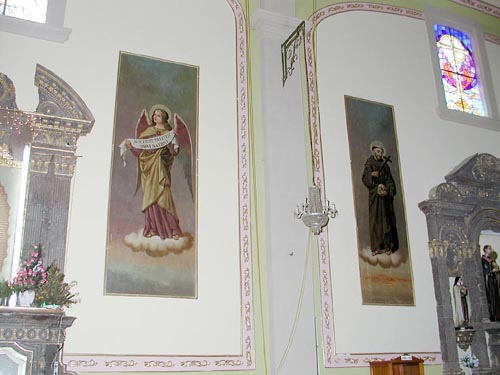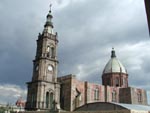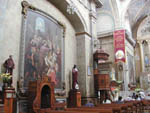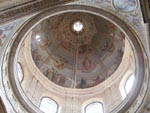The Valle de Santiago Paintings
Before the Rivas family left León for Salamanca in 1920, Candelario had secured a commission from the Santiago Apóstol Church of Valle de Santiago which would last for over a year and consist of fourteen large paintings. Candelario's oldest son, José, being an award-winning artist in his late teens, worked along with his father on these paintings, which were likely completed in a studio in León. Unlike the other highly- decorated churches that have Candelario's work, the Santiago Apóstol Church has never had the funds to afford elaborate frames and mounting structures for the artwork. Today, the paintings are yet without frames, but remain clean and maintained as the rest of the church is. One interesting note: Candelario must have really liked the family dog photographed in the family portrait taken in the León studio; he painted him as the customary dog next to St. Dominic in one of the high vertical paintings (see Mexico gallery).

Although still without frames, each of the fourteen Rivas paintings remains exceptionally well preserved. Besides ten rectangular paintings on canvas, four oval paintings of the four evangelists are located at the base of the dome.
Salamanca
As Candelario entered his forty-third year, he moved the family to Salamanca to work on perhaps his most brilliant paintings at the Catedral Señor del Hospital of Salamanca. This must have been a memorable three years, as Candelario experienced strong professional, personal and spiritual rejuvenation.
The family had lost two infants to stomach ailments: Rafaelito in 1904, and the first Salvador in 1909. Also, Herlinda had been told that she would not likely have additional children after the birth of the second Salvador in 1909. She had tragically injured herself during the birth as she tried to attend to her dying two-year-old. But in the autumn of 1920, the forty-year-old Herlinda was advised by the doctor that her nagging nausea was actually morning sickness, and another baby was due the following April! This baby was Maria Elena, and Carmen was born two years later.
On the professional side, Candelario enjoyed sharing the immense Catedral Señor del Hospital commission with his son José, who was now an award winning artist in his early twenties.
In the midst of this great endeavor, Candelario suffered a serious bout with pneumonia, and the word spread thoughout the city that the master artist from Zacatecas was home in bed, too ill to work. As Herlinda treated him with homeopathic medicine, a crowd holding candles gathered outside their home and prayed for his health. He made a complete recovery and regained the strength to finish the difficult and somewhat dangerous work on the magnificent dome murals.
The work in the Catedral Señor del Hospital of Salamanca took two and one half years. Along with the seven large wall murals, the commission also included four oval ceiling murals at the base of the dome, and the entire inside of the dome as well. Candelario's son José completed the fourteen Stations of the Cross (No. 14 is under the red banner) and one of the oval ceiling murals. He also rendered the Our Lady of Guadalupe painting mounted high on the right side altar.
Our Lady of Guadalupe
Our Lady of Guadalupe or the Virgin of Guadalupe is arguably Mexico's most popular image, and perhaps the most viewed image in the world with moving sidewalks continually moving pilgrims and tourists across its protective display. Tradition holds that the Virgin Mary appeared to the Native Juan Diego Cuauhtlatoatzin in 1531 and presented him with the image on what is now described as the Blessed Tilma. It is currently housed in the Basilica of Guadalupe in Mexico City. Also a political image, both Miguel Hidalgo and Emiliano Zapata carried the image with them during their revolutionary offensives.
However, ever since its origin, the icon has been subject to great controversy, and in the last century, there have been several attempts to conduct scientific analysis to determine its origins. The most comprehensive was conducted in 1999 by Professor Leoncio Garza-Valdés of the University of Texas at San Antonio. His instrumentation revealed the current image to be dated around 1625, and to be painted over a somewhat different image dated in 1556.
In 1921, a factory worker placed a bomb just a few feet away from the Tilma, and the explosion demolished the marble steps, severely bent a brass crucifix, and shattered windows from across the street. The official word was that the Tilma was undamaged and that it would be two years before it could be remounted again with new construction. But recently, the Basilica has presented evidence that the Tilma was secretly retouched before it was displayed again in 1923, and so it might have indeed been at least somewhat damaged.
Twelve years after the Tilma was remounted in Mexico City, Candelario Rivas was in Pasadena, California, painting a portrait for his lifelong friend, Arturo Gutierrez. As Arturo's soon-to-be bride, Maria Elena Asencio sat for her portrait, Candelario would tell her and Arturo stories to keep their interest during the long setting. He told them of his kidnapping by Pancho Villa, and a most unusual story from his last days in Mexico. Late one evening in 1923, the Archbishop of Mexico City's carriage arrived in front of the Rivas house in Salamanca. Although he had not mentioned it to his family (except perhaps Herlinda), he was expecting it and quickly entered the carriage alone, only returning after several days. Candelario revealed to his two close friends that he had been summoned by the Catholic Church to secretly work on the Blessed Tilma in Mexico City.
Many years later, when Gene Magallanes Rivas discussed this with Arturo and his wife, they were adamant that they were told the truth. They informed Gene (though he had already known) that Candelario was honest to a fault, a thoroughly religious man who would never consider anything but the truth.
In 2001, Gene had this same discussion with an assistant to the Curator of the Basilica in their offices at the Basilica complex in Mexico City. Gene was fortunate that she spoke fluent English so they could have a clear discussion on this delicate topic. He told her that select members of the Rivas family had always known (Arturos story confirmed what the Rivas family knew) that Candelario Rivas had secretly been retained by the Catholic Church to repaint parts of the Blessed Tilma. And that he was indeed the artist responsible for the fixes painted in 1923. The assistant curator was not only receptive to this discussion, but she agreed that he (Candelario) was probably the one.
After they both understood that there would never be any supporting documents to find, they mutually agreed that there were two reasons why the Catholic Church would select him. First, he (Candelario) had been trained by the Catholic Church to create grand religious works of art in Mexico, and that he had perfected the ability to replicate the great religious masterpieces in Europe so that they could be seen by the public in Mexico. And coming from out of town as a faithful servant of the Church, he was the ideal candidate. At the conclusion of our meeting, Gene informed the assistant to the Curator of a possible way to prove what they discussed. Candelario had a unique process of applying gold paint that has endured for over one hundred years. By analyzing the gold on the Tilma, and comparing it with his other known works, they could scientifically prove what Gene and the family already knew, that Candelario Rivas was indeed the late unknown artist of the Blessed Tilma.







